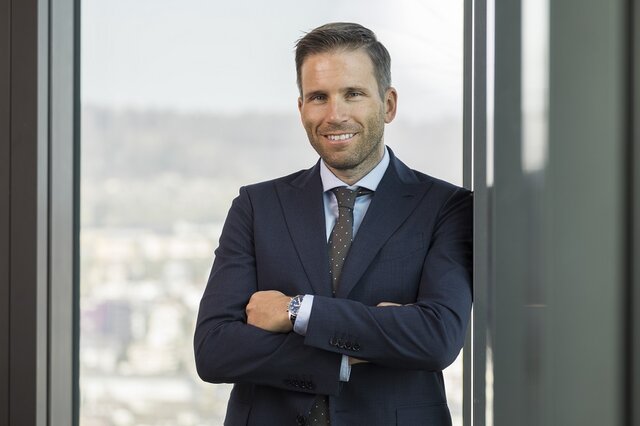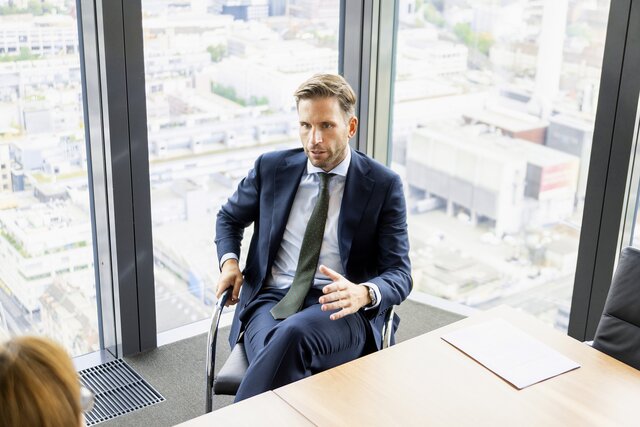
Investor appetite for land, bricks and mortar is increasing once again. With CHF 12.7 billion in assets under management, specialist property asset manager SPSS is one of the biggest players here. finews.ch talks to CEO Anastasius Tschopp about the fascination of construction and the prospects for the real estate industry.
Mr Tschopp, in the world of finance, the real estate sector is sometimes seen as a little grey; stable, but boring …
That’s news to me. Anyone who has that impression should really visit a construction site. You’ll very soon understand how you can develop a passion for manual trades. For example, when a tiler comes to a bathroom that has just been plastered. When the work is done and you leave the bathroom, it’s beautiful and finished, wherever possible with great materials like natural stone that is thousands of years old.
You speak with plenty of passion. Where does your enthusiasm for real estate come from?
It’s rooted in the fact that I’m a trained tiler. I then went on to sell building materials and from there I switched to management. Real estate is attractive because it affects us all. Living, working, infrastructure … practically every person in Switzerland invests in real estate, through their pension fund at least. Real estate is a diverse, fantastic world.
But it’s great when, for example, you can transform an old building into something ultramodern, not just tear existing buildings down. When I was still a portfolio manager at Swiss Prime Site (SPS), one of the projects I was responsible for was Brandschenkestrasse. We actually wanted to refurbish the office building and the space and let it out as offices again. Then we reconsidered our strategy and instead created 400 hotel rooms, in what is now MotelOne. It is a building with people going in and out all the time, a building that brings joy.
«It’s great when you can transform an old building into something ultramodern»

On that subject, is the MotelOne actually going well?
The chain has a global occupancy rate of around 80 percent, which you can see from the business reports. And I think Brandschenkestrasse is going well … but I can’t tell you any more than that, because I’m not in charge of operations there.
Let’s talk about your employers. We know Swiss Prime Site, or SPS, as a listed real estate company with its flagship Prime Tower. Not so well known is the Swiss Prime Site subsidiary SPSS, which you have led since it was established in 2017. What does the extra S stand for?
The S stands for Solutions. And the distinction is very clear: SPS has an existing portfolio worth CHF 13.1 billion. That includes Prime Tower, for instance, and the Jelmoli building, as well as numerous development projects. SPSS, on the other hand, works on behalf of third parties. We manage assets for institutional and private real estate investors through investment foundations, funds, mandates and club deals.
What was the thinking behind the decision to set up SPSS?
We wanted to create an investment platform for institutional and private real estate investors: pension funds, foundations, family offices, and so on.
How has the business developed since then?
When we established the investment foundation there were just a few of us in the team and around a billion in assets under management. Then there was a rapid ramp-up to CHF 4 billion and around 30 employees. We grew further with acquisitions; two and a half years ago we bought Akara, which took us to around 80 employees. And recently we added Fundamenta with their operations in Switzerland and Germany.
«We manage assets for institutional and private real estate investors through investment foundations, funds, mandates and club deals.»
That means we now have 140 employees and over CHF 12.7 billion in assets under management. This makes us the largest independent company among the Swiss asset managers in the real estate sector.
What do you mean by «independent»?
It means we don’t have our own book, so we don’t manage customer funds directly. When we have an issue, the capital always has to first be subscribed by our customers. Some competitors have their own book, for example asset managers, insurers and banks.
How would you describe the product range?
It is very broad. It includes funds, with which we now cover not just commercial real estate but residential as well, investment foundations, and exacting individual mandates. When someone comes to us wanting to establish a real estate portfolio – for example, CHF 300 million in residential real estate with a focus on Central Switzerland – we can make it happen. Or they want us to take over management of existing portfolios … we have the expertise and the capacity for acquisition, construction, development, sale, portfolio and asset management, sustainability, property management, and so on.
Where does the most demand come from?
Naturally it’s the institutional investors. In fact for regulatory reasons, certain products are only accessible to pension fund schemes.

How would you describe the current market dynamic?
It has been a little more difficult in the past couple of years, because there were general fears of a major price correction. So there was a proportion of investors who were tending toward selling. We, on the other hand, always assumed that there wouldn’t be a major correction in the area in which our products operate. You can clearly see that Switzerland is in a completely different position to other countries. The market remains strong and demand is picking up again. You can sense the appetite.
«As I see it, the risk-return profile outside A and B locations is still a mismatch»
Where do you see the most potential for returns?
In cash flow yields and the potential for a future increase in value of commercial real estate. Beyond the prime locations there has been a slight devaluation in recent years. We have invested anti-cyclically. For example, two years ago, we made acquisitions that are now offering strong yields.
As I see it, the risk-return profile outside A and B locations is still a mismatch. You get a lot of yield for little risk. If Switzerland grows to 10 or 11 million people, then they want, indeed must have, places to work, shop and live.
Is that your scenario for population growth?
We’re working on the assumption that we will cross the 10-million mark some time around 2035 or 2040.
What does that mean for construction?
When you consider what we will need in the way of building stock for 10 million people, you arrive at a total investment requirement of around CHF 200 to 300 billion, or about CHF 20 to 30 billion per year. So we have to start talking about densification and rezoning, about larger projects like social housing, infrastructure, logistics, and so on. We really have to look at this issue as a whole. Switzerland is zoned. If we don’t start thinking about densification, streamlining planning permission procedures and looking for better solutions, getting on top of all these issues will be a gigantic challenge.
«A Switzerland with 10 million people will require an investment in building stock of around CHF 200 to 300 billion»
Where are the hurdles?
In the regulatory space, for one. One concrete example: in the city of Zurich we own an old building with 12 apartments. As an existing property it can be occupied. With rebuilding you could expand it to 18 apartments, but under noise protection provisions it would be classified as uninhabitable, despite the best triple glazing. If we get in each other’s way and impose unnecessary restrictions, we will never reach Switzerland’s net zero target for CO2 emissions by 2050.
Were the higher interest rates painful for you?
Actually, we were fine with them. Fluctuations between 1 and 2 percent really aren’t a major stress for us. Because of Finma regulations, things like regular stress tests for interest rates, changes in value, vacancy rates, capital recalls and so on are part of our day-to-day business. We are very well positioned with our products, which is ultimately reflected in our performance.
Would you actually be open to further acquisitions?
Never say never. But at the moment, with our range of products and our organisation of 140 employees, we are very well placed to scale up organically.
Will you be launching more of your own funds or working with the existing ones, with capital increases?
The clear focus is on growth with existing products. That’s one of the things our customers value – greater volume and better tradeability. But of course we’re always thinking about new products, in the thematic area as well.
Where is the bottleneck for further organic growth? On the investor side or on the property side?
It’s a classic chicken-or-egg question. As we see it, in the future there will be more bidding processes where you will have five to 10 potential purchasers, particularly for investment properties in the residential segment. At the same time it would now be hugely interesting to invest in commercial property (anti-cyclically in B locations, for example) where current opinion sees a mismatch in the risk-return profile, as we discussed earlier on. This becomes very much apparent when you look at the returns for our Investment Fund Commercial (IFC).
«For investors, it’s going to get harder to find the right properties.»
Overall, we assume that there will be more capital flowing into the market again, as the key data for Switzerland really speaks in favour of real estate. So it’s going to get harder to find the right properties. However, on the acquisition site, our teams have very good access to the market. We also have around 20 to 30 percent off-market deals, which have come about through long-standing relationships. For the corresponding organic growth we can adjust cyclically, either on the capital or property side. Not least because of our diversified product range.